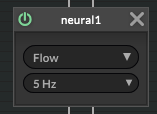@bendurso I can't quite remember. Reading the post it seems to be related to how my webserver was redirecting the traffic. I'll take a look in the AM to see where I left off
Posts
-
RE: Server.downloadFile with signed Amazon S3 URLposted in General Questions
-
RE: Linux vs ThirdParty Nodesposted in General Questions
@d-healey Exported plugins store their data (presets, documentation, etc.. ) in .config within the Company subfolder. Just like the structure on MacOS and Win. I just don't understand why it would be different for Linux.
-
RE: Linux vs ThirdParty Nodesposted in General Questions
@d-healey said in Linux vs ThirdParty Nodes:
If you delete the one in your .config folder I don't think it will change anything.
Is there any reason that HISE creates an additional folder .hise in the first place?
If AppData = ~/Application Support = .config, and HISE stores its program junk in AppData (Win) and ~/Application Support (MacOS), why doesn't it use .config on Linux for consistency? -
RE: Linux vs ThirdParty Nodesposted in General Questions
@d-healey in my distro this is also the equivalent of app data.
Not sure why both get auto-generated -
RE: Linux vs ThirdParty Nodesposted in General Questions
@iamlamprey I remember somewhere that the configuration exists in 2 different places for some reason. You might be editing the wrong one.
-
Linux + Bitwig Crash in hise::GlobalServer::WebThreadposted in Bug Reports
I’m running into a crash on Linux that I’ve traced to hise::GlobalServer::WebThread, and I’m wondering if anyone else has seen this before. The plugin runs perfectly in Linux Standalone and Reaper. Windows/macOS is fine on all DAWS.
In Bitwig on Linux, the VST3 loads fine… but crashes when HISE’s WebThread attempts to download & parse JSON (update check, preset manifest, UI image metadata, etc.)When the crash happens, the backtrace lands here:
juce::JSON::parse() juce::JSONParser::throwError() hise::GlobalServer::WebThread::run() abort()@d-healey have you encountered this before?
-
RE: Ableton Automation can't do math?posted in General Questions
I have something similar happen in Cubase. Haven't had a chance to investigate yet.
-
RE: Unlocker - How to use?posted in General Questions
@Christoph-Hart said in Unlocker - How to use?:
you can implement your own server database that handles this
yeah... at the end of the day, I created a whole License Manager wordpress plugin that communicates with the plugins.
-
RE: License Manager (Wordpress) Deactivation helpposted in Scripting
@DanH @Christoph-Hart
What OS are you testing on? I have a user on Yosemite 10.10.5 that's getting a "Status 0" reply from our server, but can login/activate/deactivate my older plugs. Thinking maybe something with a recent commit.
Might be related? -
RE: Audio Spike when loading a Neural Network node.posted in ScriptNode
@Christoph-Hart said in Audio Spike when loading a Neural Network node.:
thanks @Dan-Korneff for the contribution!
It's nice to feel useful for once

Got a few more enhancements coming soon... -
RE: Audio Spike when loading a Neural Network node.posted in ScriptNode
@Christoph-Hart
 I make a PR today. Also have a fix for the bypass being ignored.
I make a PR today. Also have a fix for the bypass being ignored. -
RE: Audio Spike when loading a Neural Network node.posted in ScriptNode
@Christoph-Hart you might want to consider adding a HPF as well. Many models contain a DC offset and filters are built into the NAM player for this reason.
-
RE: Audio Spike when loading a Neural Network node.posted in ScriptNode
I've added a filter to remove DC offset in the Neural node and it seems to have solved this issue for me. Gonna do more testing this week to be sure.

-
RE: 12dB lowcut?posted in Newbie League
Stacking two 1-pole (6 dB/oct) high-pass filters is definitely an option, but it doesn’t behave exactly like a single 12 dB/oct design. The slope doubles, but the overall response (phase and the cutoff alignment) will be slightly different.
The SVF can do a true 12 dB/oct response that's mathematically “neutral”.
If you need more control over the resonance, a Sallen–Key filter is another solid choice for a 2-pole high-pass filter.
-
RE: Bypassing scriptnode Bypass node via knobposted in ScriptNode
Maybe an X-Fader would work for you.
HiseSnippet 1179.3ocuW80SiaDDecBl.oW6wIcR807HWEBECgbf5CGPfzF0CH5LEcugVVulrJ16ZYuFHspu2OV8iz8MncF6MI1IAZTp5EjPYm+r6uYleyra5GqX7jDULwp90ih3DqWY6NRpGzY.UHI8NiX8c1WPSz73F4hNcTDMIg6Qrrp9Sn.qMWij84Ke3TZ.Ux3SEQH2nDL9GEgB8To8O9WDAAcod7qEgErt0w8XJYGUfJEvSU6ljHJaH8d9kTzrJ1jellLfX8C1Gr29rVdu2au8N3n1LZa9Q9Teem88Z0p8gG4r+QzVG1l27.h05m6IzpXWMUySHVqcpxaj6.0ix7C3FQh3t.Ntvg3Bmbt3tp.OLDQojNCDAd8GmnRHvtzeZZqZdZ6s1WH7DSjOM8sUlhFS8nXBzpRY3UsD7bJBulEf2BfjUAHsVNjdisKKVDompAwy2X2SBUSeJTmJBkbaIV+kcGEXfTuaHcHuaLrXhCa2tYycZ.+6c+nepjoEJYCk7Rklekb62U+2quY8+ndiYU46uPc3wDqBB3wKTMRMheIG2VlFdGOdmFOPCR4SLDB+x4T6mOmVrjyxi5BFpj8jB8UQb4yQDHlTE7ses2YTMEKDFYfcQ7Xs.gf0Y7Gf1f7xxl1mwSFpUQPivb0Lfsn7RCn5xTHrQyn.xAkpaXwQlHziJ1HNKuZskiW8xz9kEtuwtuPyFrX7VYA3ExZ+eiWSW52ZetuOmomB10r694udsj0MsjvYhG9qLKaz8yNKrY7OsmR7ih4QzX90p9AzQamPCiB3eBv3NMtKPwF5J9M97cKQ4P3TzhsYCnRIOHYUZpVeoyJNuXVg7IUpVHu+BpNV7DzcdYZnKLumw6XPGHypB1akutItF4HtboW1h+F9XT5fqsLJcFqrPa4kb8ip3gYkCy2IV0xy8IYI4a8exgbRPf5wNpvHggwB0fLY8UAihFnjBFJJ2hwH8jPUJbHF3BWMcMUDfTb2zDXng2URWv3r6CspdCONIaiqY2bW3OfxeoxCTUqKkAI1Q8o5AXuCNGBHm73cYSHokvZQdR9EikTi653qPySb.pCwrAdAJVx5SiA2fQ53joJVUKLoJmzhqf1yJ4GcujaPsLZ.4FjTfNkcJn4lfXczzMrexGtSOlTJh1JKh.p0tFsyi+IN9xXeFjVYFj9ZjJUH1LfMu5Plw30wAW7w1rg8GgLNMF3QOhittlFeOWmcHEEXltK4YMMIkWZxE87voLIJe8s2kEnjIPBUU2dR3SdwslTHRvpx3U.XuPHM3d5.zKnOMiru7AWMOBmJTzN2g7GyKOEsDyH0ry2f415y39zz.8bxOIUqBgoAdSHDFdP4vuDY36KPuKZz7bhxax+IhwyPgmi93FpT5AvrorWkNg97V73L78RUkmuDUKOgBX7NEY4JWac7zxkssCLfXwkpkr7.OAXonpSZ8JwRGyEHmpTCCoYyOWsW370XZeHkEqt0LkAC0Mxj.zBYFUZS3Gv.qa3PdX1jWH7z7aYrxa0bNt2p539qpisVUGOXUcr8p536WUGO7e2Q7WNYFyfzVnuo+4YjPKqykT38FYCLH+SeJu.I -
RE: AAX compile error - Develop branchposted in Bug Reports
@ustk Sorry for the super late reply. Completely missed this one.

@Adam_G I just downloaded the latest AAX SDK and HISE on W11 and everything is working as expected.
Is it possible that you've compiled both the Multi-threaded and Multi-threaded DLL Libraries? That may cause confusion when exporting. I would delete the AAX build folder and compile the Multi-threaded library again. See if that makes any difference. -
RE: Moonbaseposted in General Questions
@Christoph-Hart said in Moonbase:
JUCE_USE_BETTER_MACHINE_IDS
https://github.com/juce-framework/JUCE/commit/120f9266dc881c81371109c69b37a0a246accdeb
Here's the fix
-
RE: Moonbaseposted in General Questions
@Christoph-Hart I think there's been an update since then. I've had to integrate from JUCE 7 to fix.